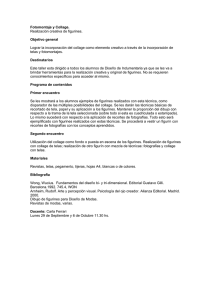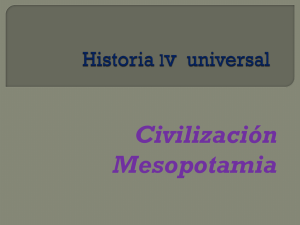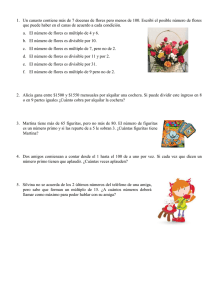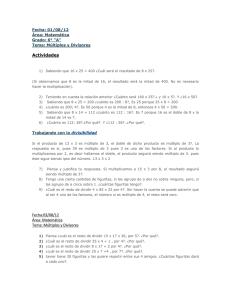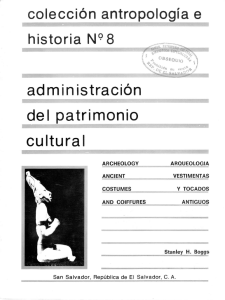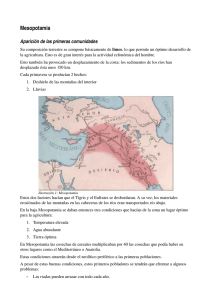Imagen aérea de uno de los zigurats de Babilonia. Imagen
Anuncio
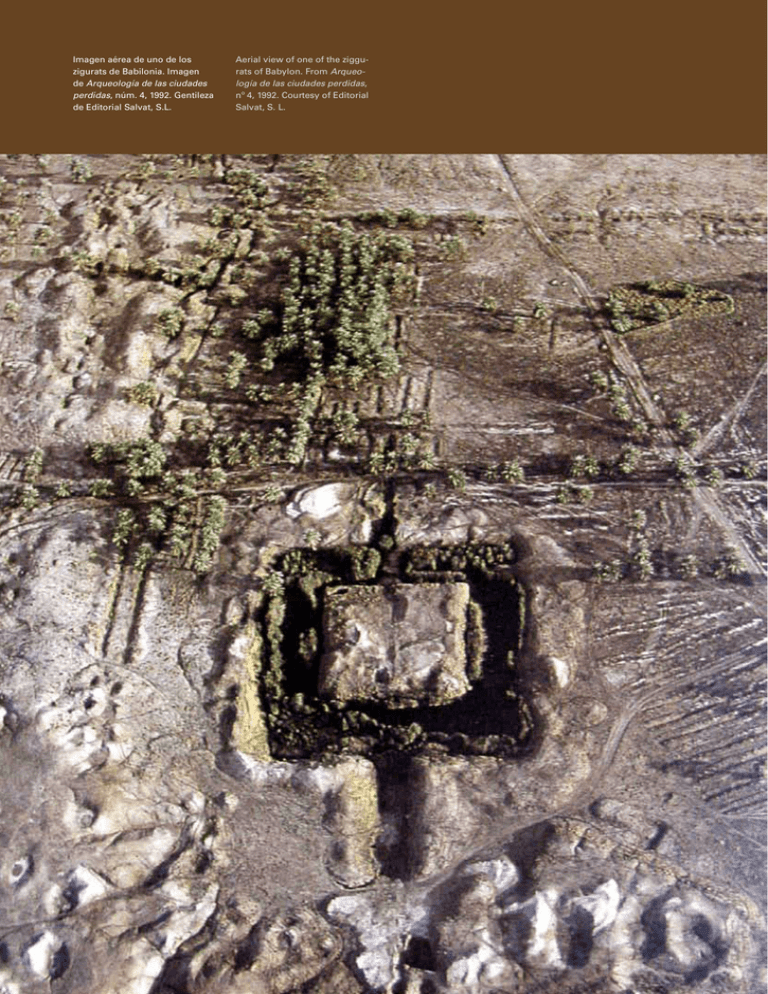
Imagen aérea de uno de los zigurats de Babilonia. Imagen de Arqueología de las ciudades perdidas, núm. 4, 1992. Gentileza de Editorial Salvat, S.L. Aerial view of one of the ziggurats of Babylon. From Arqueología de las ciudades perdidas, nº 4, 1992. Courtesy of Editorial Salvat, S. L. Tejidos mesopotámicos de 4.000 años de antigüedad: El caso de las figuritas de fundación Mesopotamian fabrics of 4000 years ago: the foundation figurines por / by Agnès Garcia-Ventura Todo el mundo conoce el cuento de Hans Christian Ander- Everyone knows Hans Christian Andersen’s tale about the sen acerca de los dos sastres que prometen al emperador two tailors who promise the Emperor a new suit of clothes un mágico traje nuevo que será invisible para los ignoran- that only the wisest and cleverest can see. When the Emper- tes y los incompetentes. Cuando, por fin, el emperador se or parades before his subjects in his new clothes, a child pasea ante sus súbditos con el supuesto traje nuevo, un niño cries out, “But he isn’t wearing anything at all!” grita: «¡Pero si no lleva ningún traje!». A menudo, lo que aquí es simplemente una fábula sucede en realidad a quienes nos dedicamos al estudio de tejidos antiguos. De algún modo, actuamos como el niño de la fábula vociferando algo obvio, aunque en nuestro caso sería lo contrario que en el cuento de Andersen: «¡Pero si lleva algo! ¡Mirad qué tejidos!». Para ilustrar esta situación, en este artículo presentaremos brevemente dos grupos de figuritas de fundación procedentes de Mesopotamia (ca. 21002000 a.n.e.),1 que conservan restos de tejidos o impresiones de los mismos. Se trata de hallazgos procedentes de Tello (antigua Girsu) y de Nippur (ver fig. 1), donde se encontraron algunos de los depósitos de fundación datados a finales del III milenio a.n.e. más bien conservados. In the study of ancient textiles, I often think we act like the child in the fable, shouting out the obvious. But in this case it’s the other way round: “He is wearing something! Look at the textiles!” To illustrate the point, in this article I will focus on two groups of foundation figurines from Mesopotamia (21002000 BC),1 which bear textile remains and textile impressions. These finds were made at Tello (ancient Girsu) and Nippur (see fig. 1), where some of the best preserved foundation deposits from the end of the Third Millennium BC were discovered. Foundation rituals in Mesopotamia: fabrics in foundation deposits Los rituales de fundación en Mesopotamia: los tejidos en los depósitos de fundación En Mesopotamia, la construcción de templos y otros edificios públicos se asociaba a una serie de rituales. Estos rituales incluían la deposición de varios objetos enterrados en los In Mesopotamia, the building of temples and other public buildings was associated with a series of rituals. During these rituals, objects would be buried in the foundations. Today, these artefacts provide us with information about the rituals themselves, the political situation, and images of Tejidos mesopotámicos de 4.000 años de antigüedad: El caso de las figuritas de fundación 19 Mesopotamian fabrics of 4000 years ago: The foundation figurines cimientos. Actualmente, estos artefactos nos aportan información acerca de los rituales en sí, de la situación política y de las imágenes de poder que tenía la gente, entre otros. Se trataba de rituales similares a los que todavía hoy en día realizamos en nuestras sociedades al construir un nuevo edificio con actos como la deposición ritual de la primera piedra o incluso, en algunos casos, el entierro de algunas maquetas del proyecto u otros objetos de carácter simbólico. Los llamados depósitos de fundación solían contener una caja que, a su vez, incluía varios objetos. Algunos de los objetos más comunes eran ladrillos, tablillas y figuritas. Todos estos objetos podían estar o no inscritos y podían ser de varios materiales. Pero en esta lista habitual de los posibles contenidos o de los hallazgos en los depósitos de fundación suele olvidarse un elemento del que, al menos en un par de yacimientos, se han encontrado restos. Se trata de los tejidos. Es bien sabido que pocos tejidos antiguos llegan hasta nosotros, en especial los procedentes de la antigua Mesopotamia, donde los altos niveles de salinidad del suelo combinados con altísimas temperaturas hacen que su supervivencia sea escasa. Pero en el caso de estos depósitos, la protección extra procurada por las cajas que contenían los objetos y el hecho de encontrarse en contacto con metal han sido los dos factores que han favorecido su preservación. Y es que, en estos casos, los restos de tejidos, tafetanes, eran antiguos envoltorios de las figuritas encontradas en los depósitos. Se trata pues de hallazgos excepcionales y, como veremos a continuación, evidentes en al menos diecinueve figuritas de fundación de los conjuntos que aquí presentamos. Pero pese a esta evidencia de una buena proporción de figu- 20 Datatèxtil [ 25 ] power. In fact similar rituals are carried out in our own times when we construct a new building, with ceremonies such as the laying of the first stone or in some cases the burial of plans of the project or other objects of a symbolic nature. Foundation deposits usually contained a box carrying a variety of objects. Some of the most common objects were bricks, tablets and figurines. These objects may have been inscribed, and could be made of a variety of materials. But in this list of the possible contents or finds in the foundation deposits, one element is consistently left out, even though remains have been found at a number of sites. I am referring, of course, to fabrics. It is well known that very few ancient fabrics have come down to us, especially from Mesopotamia, where the high temperatures and high levels of salinity make the preservation of fibres extremely rare. But in the case of these deposits, the additional protection provided by the boxes containing the objects and the fact that they were in contact with metal were two factors that have favoured their preservation. In fact, in these cases the fabric remains – taffeta – were wrappings of the figurines found in the deposits. So these are highly unusual finds and, as we will see below, are recorded in at least 19 foundation figurines in the series that we present here. But in spite of this evidence of a large proportion of figurines wrapped in cloth in the two series, the fabric remains are rarely mentioned in references to these figurines, which are well known in studies of Mesopotamian art. One of the consequences of the neglect of the fabrics ad- Fig. 1. Mapa del sur de Mesopotamia en el que se destacan las ciudades de Nippur y la antigua Girsu (Tello), donde fueron hallados los depósitos de fundación que presentamos en este artículo (a partir del mapa de enclaves del sur de Mesopotamia de Zettler, Richard L., «Archaeology and the Problem of Textual Evidence for the Third Dynasty of Ur», Bulletin of the Canadian Society for Mesopotamian Studies, 38, 2003, pp. 49-62, fig. 1). Fig. 1. Map of southern Mesopotamia showing the cities of Nippur and ancient Girsu (Tello), where the foundation deposits described in this article were found (based on the map of enclaves in southern Mesopotamia in ZETTLER, ritas de dos conjuntos envueltas en tela, los restos de tejido rara vez se mencionan cuando las figuritas, muy conocidas en los estudios de arte mesopotámico, se citan o estudian. Una de las consecuencias de la falta de atención que han recibido los tejidos adheridos a las figuritas es que todavía no se han realizado análisis que permitan determinar de qué fibra están compuestos, aunque las dos candidatas serían el lino y la lana. Uno de los excavadores de Tello, Henri de Genouillac, aventuró que la lana parecía una opción más plausible que el lino (De Genouillac 1936: 90) al ser una fibra de uso más frecuente en la Mesopotamia del 2000 a.n.e. Pero precisamente con este mismo argumento, otros estudiosos parecen inclinarse por el lino al ser una fibra menos habitual, usada como envoltorio para estatuas divinas y ser así un claro marcador de estatus (v. propuesta de Basmachi 1972: 471, para las figuritas de Nippur). En cualquier caso, hasta que no se realicen análisis de las fibras será imposible determinar con certeza si se trata de materiales de origen animal o de origen vegetal, dos posibilidades con distintas implicaciones simbólicas. Y es que poner estos restos de tejidos en el centro de la investigación, considerando las telas como un material elegido dentro de las restringidas listas de materiales incluidos en los depósitos de fundación, arroja también luz sobre su uso simbólico. Más allá de una primera visión del envoltorio de tela como protección, planteamos aquí que se puede reflexionar sobre cuestiones como las relaciones de poder establecidas entre quien producía estos tejidos, quien los disponía sobre las figuritas y a quién representan las figuritas que los llevan como si de ropajes se tratara. Todos estos temas que surgen al poner sobre la mesa las evidencias de tejidos abren numerosas posibilidades de interpretación para futuras investigaciones. Tejidos en las figuritas de fundación de Tello En Tello se recuperaron cuarenta y una figuritas de fundación, en forma de clavo, encargadas por el rey Gudea de Lagaš. Éstas pueden clasificarse en tres grupos según el personaje que representan: dioses arrodillados, reyes con una Richard L., “Archaeology and the Problem of Textual Evidence for the Third Dynasty of Ur”, Bulletin of the Canadian Society for Mesopotamian Studies, 38, 2003, pp. 49-62, fig. 1). hered to the figurines is that no analyses have been carried out to date that might determine the fibre from which they are made. The two most likely candidates are linen and wool. One of the excavators at Tello, Henri de Genouillac, suggested that wool was a more likely option (de Genouillac 1936: 90) as it was the most widely used fibre in the Mesopotamia of 2000 BC. But using precisely the same argument, other scholars favour linen: as a less common fibre, it might have been used as wrapping for statues of gods as a clear marker of status (see Basmachi 1972: 471, with refe­ rence to the figurines of Nippur). In any case, until analyses of the fibres are carried out it will be impossible to determine conclusively whether they are of plant or animal origin, two possibilities with different symbolic implications. Putting the spotlight on these fabric remains and treating the choice of these particular materials as deliberate also sheds light on their symbolic use. Going beyond the immediate assumption that the cloth wrapping was merely for protection, we propose to reflect on questions like the power relations established between the producers of these fabrics, the people who placed them on the figurines, and the personages or gods represented in the figurines. All these issues emerge as we focus on the textile evidence, which opens up numerous possibilities of interpretation for future research. Fabrics on the Tello foundation figurines At Tello, 41 peg-shaped foundation figurines were recovered, commissioned by king Gudea of Lagaš. The pieces can be classified in three groups according to the personage they represent: kneeling gods, kings with baskets on their heads (e.g. the ones we will present for the case of Nippur) and animals. We will centre on the figures of the kneeling gods, as they are the ones with the highest number of surviving fabric remains and impressions. Specifically, we will focus on the 33 figurines commissioned by Gudea to commemorate the construction of the temple known as Eninnu, dedicated to the god Ningirsu. Many of these figurines were found in the digging campaigns led by Ernest de Sarzec (between 1877 and 1900), Gas- Tejidos mesopotámicos de 4.000 años de antigüedad: El caso de las figuritas de fundación 21 Mesopotamian fabrics of 4000 years ago: The foundation figurines Fig. 2. Figurita TG 16 (número de excavación) procedente de las excavaciones de Tello. Figurita de fundación en forma de dios arrodillado, encargada por el rey Gudea de Lagaš (de Genouillac, Henri, Fouilles de Telloh. Époques d’Ur III Dynastie et Larsa, Mission Archéologique du Musée du Louvre et du Ministère de l’Instruction Publique, Paul Geuthner, París, 1936, lám. 87, 2). cesta en la cabeza (como los que presentaremos para el caso de Nippur) y animales. En adelante nos centraremos en las de dioses arrodillados por ser las que más restos de tejidos e impresiones de los mismos nos han legado. Concretamente nos fijaremos en las treinta y tres figuritas encargadas por Gudea para conmemorar la construcción del templo llamado Eninnu, dedicado al dios Ningirsu. Muchas de estas figuritas fueron encontradas en las campañas de excavación lideradas por Ernest de Sarzec (entre 1877 y 1900), Gaston Cros (entre 1903 y 1909) y Henri de Genouillac (entre 1929 y 1931), en distintos puntos del yacimiento que hoy no podemos determinar por la falta de precisión de algunos de los primeros informes de dichas excavaciones. Ya en estos primeros informes, se mencionaba que al menos diez de las treinta y tres figuritas tenían restos de tejidos adheridos cuando fueron halladas. En especial, se describieron los restos de tejidos de una de las figuritas halladas por De Genouillac (TG 16) que fue publicada acompañada de una fotografía en la que, en la parte inferior, en una de las piernas, todavía pueden verse claramente los restos de tejidos (fig. 2). Pese a la dificultad de identificar cuáles debían ser estas, como mínimo diez figuritas con tejidos, sí podemos listar algunas de ellas gracias a publicaciones posteriores en las que se hace especial mención de la presencia de tejidos. Sería el caso de las figuritas EŞEM 1572 y EŞEM 1721 (hoy en 22 Datatèxtil [ 25 ] Fig. 2. figurine TG 16 (excavation nº) from the excavations at Tello. Foundation figurine in the shape of a kneeling god, commissioned by king Gudea of Lagaš (de Genouillac, Henri, Fouilles de Telloh. Epoques d’Ur III Dynastie et Larsa, Mission Archéologique du Musée du Louvre et du Ministère de l’Instruction Publique, Paul Geuthner, Paris, 1936, lam. 87, 2). ton Cros (between 1903 and 1909) and Henri de Genouillac (between 1929 and 1931), at different points in the site. Unfortunately we can no longer identify the exact positions because of the lack of precision of some of the early reports. The first ascounts mentioned that at least ten of the 33 figurines had fabric remains attached to them when they were found. Specifically, the fabric remains of one of the figurines found by de Genouillac (TG 16) appear in a photograph in which we clearly see fabric remains, in the lower part, on one of the legs (fig. 2). In spite of the difficulty in identifying these ten (or more) figurines, we can nonetheless list some of them thanks to later publications that refer specifically to the presence of fabrics. This is the case of figurines EŞEM 1572 and EŞEM 1721 (today in the Istanbul Archaeology Museum), MNB 1384 (in the Musée du Louvre, Paris), and finally AO 76 and AO 77 which were displayed at an exhibition on foundation rituals in the ancient world held at the Centre de Cultura Contemporània in Barcelona in the year 2000.2 Fabrics on the Nippur foundation figurines As far as Nippur is concerned, the first deposit appears to have been found during the expeditions organized by the University of Pennsylvania between 1888 and 1900, and ten more were found by the team from the University of Chicago in the fifth and sixth digging campaigns at the site (1955–56 and 1957–58) when the levels of the Third Dynasty of Ur and the temples of Inanna and Ekur were reached. In total, seven deposits were found at the temple of Inanna and four at the temple of Ekur. Each one comprises at least a brick box which in turn contains a bronze figurine. The figurines from Ekur represent the whole body of king Ur-Namma with an inscription on the skirt, while those from the temple of Inanna represent Ur-Namma’s son, king Šulgi. Unlike their counterparts from the temple of Ekur, the figurines from the temple of Inanna are pegshaped and do not bear inscriptions. They all represent the king carrying a basket on his head, possibly with clay for moulding bricks or mortar to put the bricks in place. Fig. 3. IM 61403/I (izquierda) y OIM A31017 (derecha), conservadas en el Iraq Museum de Bagdad y en el Oriental Institute de Chicago, respectivamente. Figuritas de fundación del rey Šulgi encontra- das en Nippur (Haines, Richard C., «Further Excavations at the Temple of Inanna», The Illustrated London News, 6 de septiembre, Londres, 1958, pp. 386-389, fig. 19). Fig. 3. IM 61403/I (left) and OIM A31017 (right), preserved at the Iraq Museum in Baghdad and the Oriental Institute in Chicago respectively. Foundation figurines of king Šulgi found at Nippur (Haines, Richard C., “Further Excavations at the Temple of Inanna”, The Illustrated London News, 6th September, London, 1958, pp. 386-389, fig. 19). el Museo Arqueológico de Estambul), MNB 1384 (en el Museo del Louvre, París), y finalmente AO 76 y AO 77, que se mostraron en una exposición sobre rituales de fundación en el mundo antiguo celebrada en Barcelona, en el Centre de Cultura Contemporània, en el año 2000.2 Tejidos en las figuritas de fundación de Nippur En cuanto a Nippur, el primer depósito parece que fue encontrado durante las expediciones organizadas por la Universidad de Pennsylvania entre 1888 y 1900, y otros diez fueron hallados por el equipo de la Universidad de Chicago entre la 5ª y la 6ª campaña de excavación del yacimiento (1955–56 y 1957–58) cuando se llegó a los niveles de la Tercera Dinastía de Ur del templo de Inanna y del Ekur. En total, siete depósitos fueron encontrados en el templo de Inanna y cuatro en el Ekur y cada uno de ellos comprende, al menos, una caja de ladrillo que, a su vez, contiene una figurita de bronce. Las figuritas del Ekur representan el cuerpo entero del rey Ur-Namma con una inscripción en la falda, mientras que las del templo de Inanna representan al hijo de UrNamma, el rey Šulgi. Las segundas, a diferencia de las primeras, tienen forma de clavo y no llevan inscripciones. Todas ellas representan al rey con una cesta en la cabeza, posiblemente con arcilla para moldear ladrillos y/o mortero para colocarlos. La primera de las figuritas, probablemente encontrada entre 1888 y 1900, fue comprada por la Pierpont Morgan Library de Nueva York antes de 1908. Las otras diez figuritas, recuperadas durante las campañas de la Universidad de Chicago, se repartieron entre el museo de Iraq y el museo del Oriental Institute de Chicago. Revisando las distintas publicaciones de las figuritas y los primeros informes de excavación (v. bibliografía final para algunas referencias), vemos que al menos nueve de las posibles once figuritas de fundación de Nippur tenían restos de tejidos adheridos a ellas cuando fueron encontradas. Las que tenían los restos más evidentes eran las figuritas de Ur-Namma IM 59586 y OIM A30553 y las siete figuritas de Šulgi halladas en el templo de Inanna (fig. 3). Hay algunas The first of the figurines, probably found between 1888 and 1900, was bought by the Pierpont Morgan Library of New York prior to 1908. The ten other figurines, recovered during the campaigns of the University of Chicago, were shared out between the Iraq Museum and the Oriental Institute Museum in Chicago. Looking at some of the publications that mention the figurines and the first excavation reports (see the bibliography for some of the references), we see that at least nine of the eleven possible foundation figurines from Nippur had fabric remains adhered to them when they were found. The ones with the most evident remains were the figurines of UrNamma IM 59586 and OIM A30553 and the seven figurines of Šulgi found at the temple of Inanna (fig. 3). Other publications, however, state that all the figurines of the foundation deposits at Nippur must have been wrapped in cloth.3 Tejidos mesopotámicos de 4.000 años de antigüedad: El caso de las figuritas de fundación 23 Mesopotamian fabrics of 4000 years ago: The foundation figurines Fig. 4. OIM 31017, figurita de fundación del rey Šulgi encontrada en Nippur. Es la misma que aparece a la derecha de la fotografía de la figura 3 (fotografía de Agnès Garcia-Ventura, por cortesía del Oriental Institute Museum de la Universidad de Chicago). Fig. 4. OIM 31017, foundation figurine of king Šulgi found at Nippur. It is the same one that appears on the right hand side in the photograph in figure 3 (photograph by Agnès Garcia-Ventura, courtesy of the Oriental Institute Museum,University of Chicago). publicaciones, en cambio, que mencionan que todas las figuritas de los depósitos de fundación de Nippur debían llevar un envoltorio de tejido.3 Por todo ello, creemos que se puede sugerir que, muy posiblemente, todas las figuritas de época de Ur III encontradas en Nippur pudieron haber estado envueltas en tela cuando fueron colocadas en los depósitos de fundación. De hecho, en casi todas ellas, restos de tejidos o pseudomorfos eran evidentes antes de la primera limpieza a la que todas ellas fueron sometidas después de ser encontradas (fig. 4). For all these reasons, we suggest that all the figurines from the era of Ur III found at Nippur may have been wrapped in fabric before being placed in the foundation deposits. In fact, in almost all the cases, fabric remains or pseudomorphs were evident before the pieces were cleaned for the first time after being discovered (fig. 4). Recapitulando: «El traje nuevo del emperador» revisitado Había una vez tres reyes famosos y poderosos en Mesopotamia que decidieron encargar algunas figuritas para conmemorar la construcción de distintos templos en sus florecientes ciudades: Nippur y Tello. Los tres reyes, Ur-Namma, Šulgi y Gudea, decidieron encargar unos tejidos para proteger las figuritas y dotarlas de valor añadido, para lo que contaron con las mejores tejedoras de Mesopotamia que, a su vez, emplearon las mejores fibras trabajadas con las más avanzadas técnicas. El resultado final fue magnífico. Al cabo de unos cuantos cientos de años, incluso miles, las figuritas fueron halladas y de nuevo salieron a la luz. Todo el mundo se maravilló ante la belleza de aquellas piezas de metal en forma de clavo y quedaron atónitos al descifrar las inscripciones que tenían algunas de ellas. También vieron los tejidos que algunas tenían adheridos, pero los ignoraron, hasta que algunos observadores y observadoras exclamaron: «¡Mirad los tejidos!¡Son magníficos!». Y así fue como finalmente los arqueólogos y las arqueólogas, los tejidos y las figuritas, vivieron felices para siempre. 24 Datatèxtil [ 25 ] To recapitulate: “The emperor’s new clothes” revisited Once upon a time there were three famous, powerful kings in Mesopotamia who decided to make some figurines to commemorate the construction of temples in the flourishing cities of Nippur and Tello. The three kings, Ur-Namma, Šulgi and Gudea, decided to commission some fabrics to protect the figurines and to give them added value. They sought out the best weavers in Mesopotamia who used the finest fibres and techniques. The result was magnificent. Many centuries later, the figurines were found again. Everyone marvelled at the beauty of these peg-shaped metal pieces and were astonished when they deciphered the inscriptions on some of the figurines. They also saw the fa­ brics adhered to them, but they ignored them until some of the observers cried out: “But look at the fabrics! They’re wonderful!” And so everyone, the archaeologists, the fabrics and the figurines, lived happily ever after. Bibliografía Bibliography Basmachi, Faraj, Treasures of the Iraq Museum, Baghdad, Republic of Iraq, Ministry of Information, Directorate General of Antiquities, Bagdad, 1972. Cros, Gaston, Nouvelles Fouilles de Tello, Ernest Leroux, París, 1910. De Genouillac, Henri, Fouilles de Telloh. Époques d’Ur III Dynastie et Larsa, Mission Archéologique du Musée du Louvre et du Ministère de l’Instruction Publique, Paul Geuthner, París, 1936. De Sarzec, Ernest; Heuzey, Leon, Découvertes en Chaldée, Ernest Leroux, París, 1884-1912. Ellis, Richard S., Foundation Deposits in Ancient Mesopotamia, Yale University Press, New Haven-Londres, 1968. Garcia-Ventura, Agnès, «Neo-Sumerian Textile Wrappings: Revisiting some Foundation Figurines from Nippur», Zeitschrift für Orient Archäologie, 1, Berlín, 2008, pp. 246-254. Goetze, Albrecht, «Nippur Foundation Boxes», Archaeology, 9, Nueva York, 1956, pp. 216-217. Haines, Richard C., «The Temple of Inanna at Nippur», The Illustrated London News, 18 de agosto, Londres, 1956, pp. 266-269. Haines, Richard C., «Further Excavations at the Temple of Inanna», The Illustrated London News, 6 de septiembre, Londres, 1958, pp. 386-389. Rashid, Subhi Anwar, Gründungsfiguren im Iraq, Beck, Múnich, 1983. VV.AA., La fundación de la ciudad. Mesopotamia, Grecia y Roma, Centre de Cultura Contemporània de Barcelona/Institut d’Edicions de la Diputació de Barcelona, Barcelona, 2000. Basmachi, Faraj, Treasures of the Iraq Museum, Baghdad, Republic of Iraq, Ministry of Information, Directorate General of Antiquities, Baghdad, 1972. Cros, Gaston, Nouvelles Fouilles de Tello, Ernest Leroux, Paris, 1910. De Genouillac, Henri, Fouilles de Telloh. Epoques d’Ur III Dynastie et Larsa, Mission Archéologique du Musée du Louvre et du Ministère de l’Instruction Publique, Paul Geuthner, Paris, 1936. De Sarzec, Ernest; Heuzey, Leon, Découvertes en Chaldée, Ernest Leroux, Paris, 1884-1912. Ellis, Richard S., Foundation Deposits in Ancient Mesopotamia, Yale University Press, New Haven - London, 1968. Garcia-ventura, Agnès, “Neo-Sumerian Textile Wrappings: Revisiting some Foundation Figurines from Nippur”, Zeitschrift für Orient Archäologie, 1, Berlin, 2008, pp. 246-254. Goetze, Albrecht, “Nippur Foundation Boxes”, Archaeology, 9, New York, 1956, pp. 216-217. Haines, Richard C., “The Temple of Inanna at Nippur”, The Illustrated London News, 18th August, London, 1956, pp. 266-269. Haines, Richard C., “Further Excavations at the Temple of Inanna”, The Illustrated London News, 6th September, London, 1958, pp. 386-389. Rashid, Subhi Anwar, Gründungsfiguren im Iraq, Beck, München, 1983. VV.AA., La fundación de la ciudad. Mesopotamia, Grecia y Roma, Centre de Cultura Contemporània de Barcelona / Institut d‘Edicions de la Diputació de Barcelona, Barcelona, 2000. Notas notes 1 1 This period corresponds to the Third Dynasty of Ur and the kingdom of Gudea of Lagaš. 2 See the catalogue of the exhibition: VVAA, La fundación de la ciudad. Mesopotamia, Grecia y Roma, Centre de Cultura Contemporània de Barcelona / Institut d’Edicions de la Diputació de Barcelona, Barcelona, 2000, p. 183. 3 Ellis, Richard S., Foundation Deposits in Ancient Mesopotamia, Yale University Press, New Haven - London, 1968, p. 68. Período correspondiente a la Tercera Dinastía de Ur y el reinado de Gudea de Lagaš. 2 Ver al respecto el catálogo de dicha exposición: VVAA, La fundación de la ciudad. Mesopotamia, Grecia y Roma, Centre de Cultura Contemporània de Barcelona / Institut d’Edicions de la Diputació de Barcelona, Barcelona, 2000, p. 183. 3 Ellis, Richard S., Foundation Deposits in Ancient Mesopotamia, Yale University Press, New Haven - London, 1968, p. 68. Tejidos mesopotámicos de 4.000 años de antigüedad: El caso de las figuritas de fundación 25 Mesopotamian fabrics of 4000 years ago: The foundation figurines
